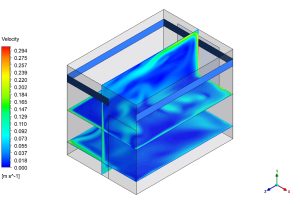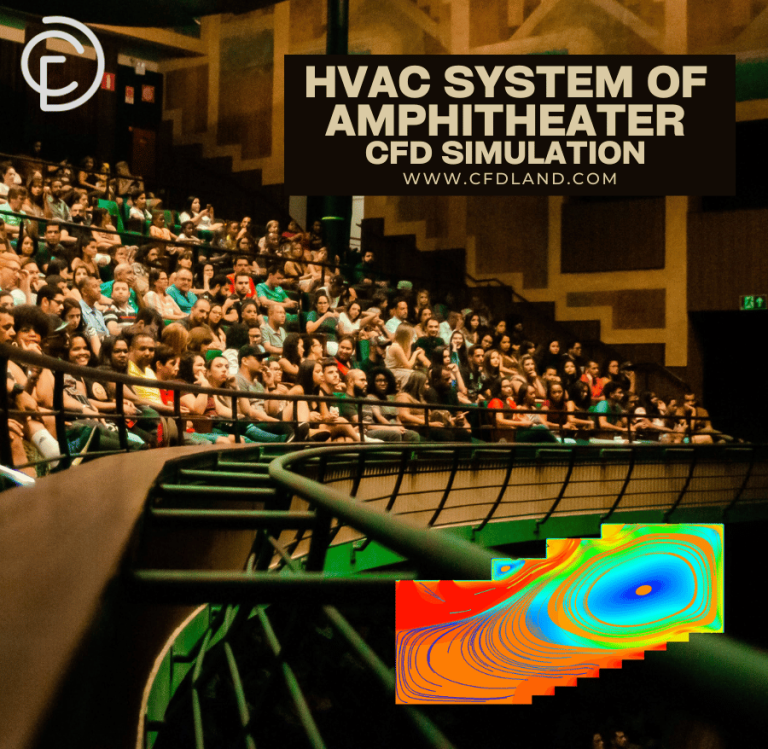Room Ventilation By Cooling Duct CFD Simulation, ANSYS Fluent Training
Room Ventilation By Cooling Duct CFD Simulation, ANSYS Fluent Training
- Upon ordering this product, you will be provided with a geometry file, a mesh file, and an in-depth Training Video that offers a step-by-step training on the simulation process.
- For any more inquiries regarding the product, please do not hesitate to reach out to us at info@CFDLAND.com or through our online support assistant.
€110 Original price was: €110.€85Current price is: €85.
Room ventilation systems are essential components of modern building design, providing crucial indoor air quality and thermal comfort for occupants. The strategic placement of cooling ducts within an enclosed space facilitates efficient temperature distribution and plays a vital role in maintaining comfortable living and working environments. In this tutorial, we examine how HVAC systems utilize ceiling-mounted ducts to create effective cooling through natural convection rather than high-velocity forced air. Understanding these airflow dynamics is crucial for optimizing ventilation performance in residential and commercial spaces, particularly when dealing with external heat sources like windows that can significantly impact the thermal balance within a room. A room ventilation system benefits from a cooling duct is numerically investigated in this independent study.

Figure 1: Room schematic equipped by cooling duct
Simulation Process
The room model is primarily created using Design Modeler. As portrayed above, a door, a window and HVAC ducts are installed. The domain is then discretized into hexagonal cells using ANSYS ICEM software. This structured mesh was established from 1078800 number of cells.
The ultimate goal of the present study is to get acquainted with the power of CFD simulations. Thus, the simplest assumptions are taken. While the window`s temperature is 37.1°C, the 9-degree ducts are expected to cool down the room.

Figure 2: Grid generation by ANSYS ICEM
Post-processing
The simulation results reveal how air moves inside the room when cooled by ceiling-mounted ducts. Looking at the flow patterns, we can see several circular motions (called vortices) forming throughout the room, where air spins in different areas rather than flowing straight. The cooling happens mainly through natural convection – cold air from the ducts naturally falls downward while warm air rises. This creates a gentle circulation that helps cool the room without needing high-speed air blasts. The blue areas in the images show slower moving air (close to 0 m/s), while the green-yellow areas show faster movement (around 0.17-0.26 m/s).
The 3D view shows how temperature differences between the hot window (37.1°C) and cool ducts (9°C) drive this air movement. The system managed to bring the overall room temperature down to about 28.5°C despite the heat coming from the window. We can see that air velocity is higher near the walls and cooling ducts (shown in green) and slower in the center of the room (shown in blue). This pattern confirms that placing ducts near the ceiling works well for cooling since it takes advantage of natural air movement – cold air falls down while warm air rises, creating natural circulation throughout the space without needing powerful fans.

Figure 3: Natural-driven cooling system in a room
We pride ourselves on presenting unique products at CFDLAND. We stand out for our scientific rigor and validity. Our products are not based on guesswork or theoretical assumptions like many others. Instead, most of our products are validated using experimental or numerical data from valued scientific journals. Even if direct validation isn’t possible, we build our models and assumptions on the latest research, typically using reference articles to approximate reality.
Yes, we’ll be here . If you have trouble loading files, having technical problems, or have any questions about how to use our products, our technical support team is here to help.
You can load geometry and mesh files, as well as case and data files, using any version of ANSYS Fluent.
€175 Original price was: €175.€145Current price is: €145.

€155 Original price was: €155.€95Current price is: €95.

€175 Original price was: €175.€115Current price is: €115.

€160 Original price was: €160.€135Current price is: €135.

€140 Original price was: €140.€65Current price is: €65.

€280 Original price was: €280.€145Current price is: €145.



















Reviews
There are no reviews yet.